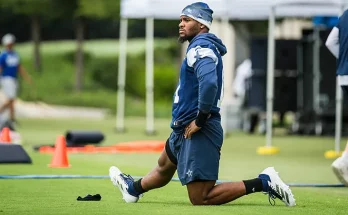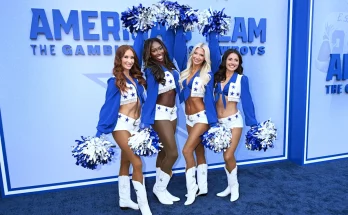After a historic, jaw-dropping performance that stunned an audience across the world, ESPN officially named the Florida State Seminoles men’s cheerleading squad the best in the world. It’s a declaration that will be remembered not just in Tallahassee, but globally. What began as a pursuit of perfection ended in dominance on the international stage. The Seminoles men’s cheer squad didn’t just win—they redefined excellence.
The recognition from ESPN didn’t come on a whim. This was the culmination of months of relentless training, technical refinement, mental preparation, and a deep-rooted desire to prove that greatness isn’t reserved for the traditional athletic fields. The Seminoles put on a show that transcended the boundaries of sport and art. In one dazzling, high-stakes performance, they captured the essence of power, precision, and passion. Millions tuned in expecting a good routine. What they got was history.
The routine itself was something of a masterpiece—flawless execution, innovative choreography, unmatched synchronization, and a level of athleticism that would leave even the most seasoned gymnasts in awe. From gravity-defying stunts to seamless transitions, the Seminoles performed with an intensity and fluidity that set them apart from every other team in competition. Every lift, every toss, every landing—perfect. Not even a flicker of doubt appeared on their faces. It was as if they had rehearsed not just for months, but lifetimes.
Observers from ESPN were quick to praise the performance as “a moment in sports history,” and they weren’t alone. Analysts, former champions, and cheerleading legends from around the globe chimed in to give credit where it was due. But perhaps the most poignant recognition came from their competitors, who acknowledged that the Florida State men’s squad had simply raised the bar beyond reach.
It’s rare for a single performance to change the landscape of a sport. Rarer still is for it to come from a team that, just a few years ago, was seen as a strong contender but not necessarily a world-beater. That transformation didn’t happen by accident. It began with a cultural shift inside the Florida State program. Head coach Landon Sutterfield, himself a former collegiate cheerleader and military veteran, brought a new mentality: discipline, respect, and elite expectations.
He was the first to believe that Florida State could be the best—not just in the NCAA, not just in the United States, but in the world. He pushed his athletes harder, held them to higher standards, and refused to accept anything less than extraordinary. That mindset trickled down to the squad’s senior leaders, who carried that torch to the rest of the team. And this wasn’t just motivational rhetoric. It was lived out every day in training, conditioning, nutrition, and mental preparation.
The chemistry among the athletes was another critical factor. Unlike other squads that sometimes struggle with egos or internal competition, Florida State’s men’s cheerleading team functioned as a true brotherhood. They knew each other’s strengths and weaknesses, supported each other through setbacks, and celebrated each other’s wins. That camaraderie showed in their performance—an unbreakable unit executing as one.
The routine also broke traditional molds. While cheerleading has long embraced complex stunts and energetic pacing, the Seminoles introduced a dramatic flair usually reserved for Olympic-level performances. The musical score chosen for the routine built in intensity and emotion, guiding the audience through crescendos and moments of suspended breath. At times, it felt like a theater performance. At others, like watching elite-level acrobatics. It was storytelling in motion, performed on the most unforgiving of stages.
That stage, of course, was the World Cheerleading Championship, held in a packed arena with millions more watching online and on television. The moment carried massive pressure. One small error could mean elimination. But the Seminoles thrived in that pressure. In fact, they seemed to feed off it. As the crowd erupted with every perfectly timed toss and landing, the team only got stronger. By the end of the routine, the judges didn’t need long to deliberate. The Seminoles had delivered something so spectacular, so undeniable, that no debate was necessary.
In the hours and days following the performance, social media exploded with tributes to the Florida State team. Clips of the routine went viral, earning tens of millions of views across platforms. ESPN’s coverage only added fuel to the fire, calling the Seminoles’ display “a generational achievement in the sport of cheerleading.” For a program that had quietly been building toward greatness, the moment was both a breakthrough and a coronation.
At the heart of it all was the shared belief that cheerleading deserves a bigger stage and deeper respect. Too often seen as a sideline activity, competitive cheer—especially men’s cheer—has battled for recognition. The Seminoles didn’t just win a title; they struck a blow for the legitimacy of the sport worldwide. They proved that male cheerleaders could be elite athletes, entertainers, and global icons all at once.
That’s why ESPN’s designation means so much. It’s not just a trophy or an article or a soundbite. It’s a seismic shift in perception. It’s validation for every rep in the weight room, every ice bath, every injury fought through, and every doubt silenced. When ESPN named them the best in the world, it sent a message to the next generation: this path is valid, this pursuit is noble, and this level of excellence is possible.
Beyond the accolades and viral fame, the Seminoles understand their responsibility now extends further. As ambassadors of the sport, they’re planning to engage in outreach with local schools, host clinics for young athletes, and use their platform to inspire inclusion, excellence, and character. Many members of the team are already pursuing careers in sports science, education, or coaching. For them, cheerleading has never just been about the spotlight—it’s about building something lasting.
In interviews after the win, team captain Jordan Wells spoke with tears in his eyes. “This is more than a championship,” he said. “This is everything we’ve worked for—day in and day out—finally being seen. We’re not here to show off. We’re here to show the world what’s possible when you believe in something bigger than yourself.”
And the world saw. From Tokyo to Toronto, from Johannesburg to Jacksonville, fans and aspiring cheerleaders alike witnessed what happens when skill meets heart, and preparation meets destiny. That fusion doesn’t happen often. But when it does, it changes everything.
Florida State’s men’s cheerleading squad didn’t just have the best routine—they became the gold standard. In every measurable category—difficulty, execution, originality, and crowd impact—they scored at the top. But it was the intangible elements—the unity, the resilience, the joy—that left the deepest impression. Watching them perform was like witnessing lightning in a bottle.
Now, with the world’s eyes on them and a legacy cemented in the annals of cheerleading history, the Seminoles aren’t planning to slow down. If anything, they’ve raised their own expectations. Already, rumors are swirling about what they might unveil next season. And if history is any guide, the best may be yet to come.
What remains undeniable is this: after one breathtaking routine that defied gravity, convention, and expectation, Florida State University’s men’s cheerleading squad didn’t just earn a title. They claimed a place in history. The best in the world—and proud of it.



